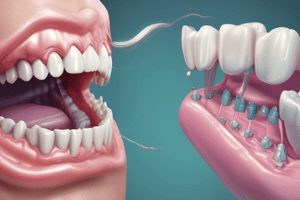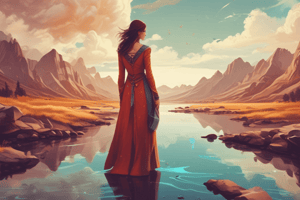Podcast
Questions and Answers
What is a key radiographic feature of periapical granulomas?
What is a key radiographic feature of periapical granulomas?
- Apical radiopacity (correct)
- Radiopaque border
- Radiolucent border
- Focal radiopacity
How does focal sclerosing osteitis present itself radiographically?
How does focal sclerosing osteitis present itself radiographically?
- Root resorption is visible
- Periapical radiolucency
- Apex of tooth is radiolucent
- Apex of tooth is radiopaque (correct)
What can potentially remain after treating focal sclerosing osteitis?
What can potentially remain after treating focal sclerosing osteitis?
- Radicular cyst
- Periapical granuloma
- Calcific metamorphosis
- Bone scar (correct)
Which feature is characteristic of granulation tissue in periapical granulomas?
Which feature is characteristic of granulation tissue in periapical granulomas?
How do periapical granulomas present themselves histologically?
How do periapical granulomas present themselves histologically?
What can be confused with periapical granulomas on radiographs, and how can they be distinguished?
What can be confused with periapical granulomas on radiographs, and how can they be distinguished?
In periapical granulomas, what leads to the formation of a radicular cyst?
In periapical granulomas, what leads to the formation of a radicular cyst?
Flashcards are hidden until you start studying
Study Notes
Periapical Periodontitis
- Inflammation of periodontal ligament and other tissues around the tooth apex
- 3 main causes:
- Spread of infection following death of the pulp (pulpitis)
- Extrusion of antiseptics through apex during root canal treatment
- High filling or biting suddenly on a hard object
Acute Periapical Periodontitis
- Clinical findings:
- History of pulpitis
- Escape of exudate into periodontal ligament causes a small amount of tooth extrusion
- Pain and infection localized, tender to touch
- Tooth not vital, and not responsive to vitality tests, unless pulpal necrosis limited to single canal in multirooted tooth
- Intense throbbing pain
- Abscess can develop
- Can spread in tissue planes causing facial swelling
- Rarely local lymphadenopathy
- Very rarely osteomyelitis or cellulitis
- Radiographically:
- No bone resorption, only widening of periodontal ligament space
- Pathology (cause): Acute inflammation
- Management:
- Endodontic treatment
- Extraction
- Open drainage through skin or mouth if needed due to abscess causing swelling
Chronic Periapical Periodontitis
- Clinical features:
- Low-grade infection
- May follow acute periapical periodontitis
- Tooth is not vital, unless very rarely pulpal necrosis is limited to a single canal in a multirooted tooth
- Symptoms may be minimal
- Can be tender to percussion
- Radiographically:
- Diagnosed on identification of a periapical radiolucency
- Pathology:
- Chronic inflammation (macrophages, lymphocytes, plasma cells)
- Granulation tissue
- Sequelae:
- Periapical granuloma
- In some cases, subsequent radicular cyst
- Acute exacerbation with suppuration/abscess, cellulitis, and sinus formation
- Very rarely focal sclerosing osteitis
Periapical Granuloma
- Clinical features:
- Most asymptomatic
- May be history of pulpitis
- But can have coexisting pulpitis and therefore be symptomatic
- Tooth is not vital and will not be responsive to vitality tests unless pulpal necrosis is limited to a single canal in a multirooted tooth
- Radiographic features:
- Tooth shows loss of apical lamina dura
- Bone resorption appearing as a radiolucency that may be circumscribed or ill-defined
- Size: Small (2cm) or Large
- Root resorption can be seen rarely
- Pathological features:
- Granulation tissue
- Neutrophils, lymphocytes, plasma cells, histiocytes, multinucleated giant cells
- Cholesterol clefts and haemosiderin
- Small foci of acute inflammation with focal abscess formation may be seen
- Surrounding fibrous wall
- Bone resorption
- Tooth can be resorbed but generally more resistant than bone
Focal Sclerosing Osteitis
- Abnormal bone growth and lesions that may result from tooth inflammation or infections
- Can cause harder, denser bones
- Most occur in lower premolar and molar areas
- Localized pain
- Radiographically:
- Does not exhibit a radiolucent border
- Treatment:
- RCT or tooth extraction - 85% of cases resolve after this
- Residual area of condensing osteitis known as a bone scar
Studying That Suits You
Use AI to generate personalized quizzes and flashcards to suit your learning preferences.




